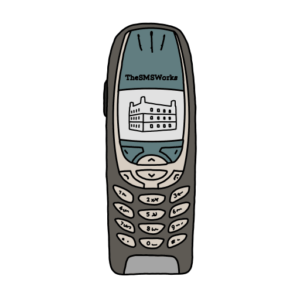What is a VoIP text message and how does it work?
VoIP stands for Voice over Internet Protocol.
VoIP is a technology that enables voice communication and multimedia sessions over the internet.
While it is primarily used for voice calls, VoIP can also support other forms of communication, including text messaging. You have almost definitely used some VoIP service, these include messaging services like WhatsApp and Skype.
VoIP text messages work by converting the text into digital data packets and transmitting them over the internet using a VoIP service provider.
The recipient’s device or VoIP client receives the data packets and converts them back into text, allowing the user to read the message.

In what ways does VoIP help a business?
VoIP can provide several benefits to businesses. Here are some ways in which VoIP SMS could possibly help your business:
Cost savings:
VoIP can significantly reduce communication costs for businesses, especially for long-distance and international calls. Traditional telephone systems often incur higher charges for long-distance calls, whereas VoIP calls are transmitted over the internet, typically at lower or fixed rates.
Additionally, businesses can eliminate the need for separate voice, data and SMS networks, resulting in cost savings on infrastructure and maintenance.
Scalability and flexibility:
VoIP systems allow businesses to get rid of their phone lines. This flexibility is particularly handy for growing businesses or those with fluctuating communication needs.
Adding new phone lines or extensions with VoIP is usually a software-based configuration, needing very few hardware changes.
Advanced features:
VoIP offers a wide range of advanced features that can enhance business communications. These include call forwarding, voicemail, call routing, call recording, conference calling, auto-attendant, and of course VOIP SMS.
VoIP systems can integrate with other business applications, such as customer relationship management (CRM) or CPaaS software, to streamline communication processes and improve overall efficiency.
Mobility and remote work:
VoIP enables businesses to support mobility and remote work arrangements, which as we all know, is incredibly important. Employees can use softphone applications installed on their smartphones, tablets, or laptops to make and receive business calls from anywhere with an internet connection.
This allows for greater flexibility and productivity, as employees can stay connected and accessible even when they are away from the office. So no escaping work!
Unified communications:
VoIP can be integrated with other communication channels, such as instant messaging, video conferencing, and file sharing. This integration promotes collaboration and enables employees to communicate seamlessly across various channels, enhancing teamwork and productivity.
Easy management and maintenance:
VoIP systems are generally easier to manage and maintain compared to traditional phone systems. Many VoIP providers offer web-based administration interfaces that allow businesses to configure and manage their phone systems conveniently.
Software updates and maintenance tasks can be performed remotely, reducing the need for on-site technical support.
Examples of VoIP SMS providers:
Here are some examples of VoIP SMS providers that you may want to explore further. Please note that this is nor a comprehensive list of VOIP SMS companies.
| Name | Rating | Link |
| Nextiva | 4.6 | https://www.nextiva.com/ |
| RingCentral | 3.8 | https://www.ringcentral.com/ |
| Zoom | 4.2 | https://explore.zoom.us/ |
| Vonage | 3.4 | https://www.vonage.com/ |
| GoTo | 4.2 | https://www.goto.com/ |
| 1-VoIP | 4.4 | https://www.1-voip.com/ |
| OpenPhone | 4.5 | https://www.openphone.com/ |
| intermedia | 4.3 | https://www.intermedia.co.uk/ |
| DialPad | 4.6 | https://www.dialpad.com/ |
| Ooma | 4.3 | https://www.ooma.com/ |
| 8×8 | 4.3 | https://www.8×8.com/ |
| Grasshopper | 2.8 | https://grasshopper.com/ |
How do you use VoIP texting in a business?
Using VoIP texting in a business involves leveraging the capabilities of VoIP technology to send and receive text messages for business communication purposes. Here’s how it can be done:
- VoIP Service Provider: Choose a VoIP service provider that offers text messaging functionality as part of their service.
- VoIP Client or App: Install a VoIP client or app on your business devices. These act as the interface for making and receiving calls as well as sending and receiving text messages.
- Text Message Sending: Use the VoIP client or app to compose and send text messages to contacts or phone numbers. The interface is typically similar to traditional text messaging apps, where you enter the recipient’s phone number or select a contact from your address book, write the message, and send it.
- Text Message Receiving: Incoming text messages are received in the VoIP client or app’s inbox.
- Features and Integrations: Explore the features and integrations available with your VoIP texting service. Many VoIP platforms offer features like group messaging, multimedia messaging (MMS), message forwarding, message archiving, and integration with other business applications like CRM systems, helping streamline communication and collaboration.
- Mobility and Remote Access: VoIP texting enables mobility and remote access. You can access and send text messages using the VoIP client or app installed on your mobile devices, allowing you to stay connected and responsive while on the go or working remotely.
- Management and Administration: Depending on the VoIP provider, you may have access to management and administration features. These allow you to control settings, manage contacts, set up auto-responses, and customize the text messaging features according to whatever your business needs.

VoIP VS SMS
| Similarities: | Differences: |
| Digital Transmission: Both VoIP and SMS rely on digital transmission methods. This digital format allows for efficient transmission over networks. | Communication Medium: VoIP primarily focuses on voice communication. It allows users to make phone calls and engage in real-time voice conversations. SMS is a text messaging service that enables users to send short written messages, typically limited to 160 characters. |
| Utilize Telecommunication Networks: Both VoIP and SMS use telecommunication networks to transmit data. VoIP calls and SMS messages are typically transmitted over cellular networks or the internet, depending on the specific technology and infrastructure in use. | Data Format: VoIP converts voice signals into digital data packets for transmission, while SMS transmits text messages as digital data packets. VoIP data packets contain audio data, while SMS data packets contain textual information. |
| Global Reach: Both VoIP and SMS have a global reach and can be used for communication across different countries and regions. | Real-Time vs. Asynchronous: VoIP enables real-time communication, where users can engage in live conversations with minimal delay.In contrast, SMS is an asynchronous messaging service. Users send and receive messages that are stored and delivered when the recipient is available to read them. |
| Cost-Effective Communication: Both VoIP and SMS are generally more cost-effective compared to traditional telephone services. | Rich Media: VoIP supports the transmission of various media types, including voice, video, and sometimes even images or files, depending on the specific implementation. SMS, on the other hand, is primarily limited to text-only messages and does not support multimedia attachments. |
| Support Multiple Devices: Both VoIP and SMS can be accessed and used on various devices. VoIP calls and SMS messages can be sent and received on smartphones, tablets, computers, and other internet-enabled devices, providing flexibility and accessibility. | Cost Structure: VoIP calls are typically billed based on data usage or specific plans provided by the VoIP service provider. SMS messages, however, are typically charged on a per-message basis, with separate charges for outgoing and incoming messages, as determined by the cellular service provider. |
| Instant Communication: While VoIP is primarily used for voice communication, it can also support real-time communication similar to SMS. | Device Dependency: VoIP calls can be made and received using various devices such as smartphones, computers, IP desk phones, or dedicated VoIP devices. SMS, on the other hand, is primarily associated with mobile devices and cellular networks. |
It must be said that VoIP SMS is not perfect, in an article on the security risks of VoIP SMS, Natália Mrázová wrote that

“VoIP can be abused by cybercriminals and scammers to damage your business. By hacking the phone system, criminals can listen to all calls you make, rack up phone bills, or steal sensitive information related to both your business and your customers. And criminals usually don’t end there.”
VOIP SMS FAQs:
What is a VoIP number text?
A VoIP number text is a text message sent or received using a virtual phone number that works over the internet instead of a regular mobile phone network.
Why would someone text using a VoIP number?
Someone might choose to text using a VoIP number for two reasons. Firstly, it can be more cost-effective, especially for international or long-distance texting. Secondly, it offers flexibility as you can send and receive texts from anywhere with an internet connection.
Can VoIP texts be traced?
Yes, VoIP texts can be traced to some extent. Information such as timestamps, IP addresses, and sender/receiver details associated with VoIP text messages can be used to track their origin and destination. However, the tracing process may not be as straightforward as with traditional SMS messages.
What happens if you text a VoIP number?
Nothing interesting! All that happens is that the message will be transmitted over the internet instead of the traditional cellular networks.
Conclusion:
A VoIP text message is a text message sent or received using a virtual phone number associated with a VoIP (Voice over Internet Protocol) service.
It allows users to send and receive text messages over the internet instead of traditional cellular networks. VoIP text messages offer several advantages, including cost savings, flexibility, and integration with other communication channels.
They can be used on various devices, providing mobility and remote access. While VoIP text messages can be traced to some extent, the process may differ from tracing traditional SMS messages.
It’s important to note that the specific implementation and features of VoIP text messaging may vary depending on the VoIP SMS service provider or application being used.

